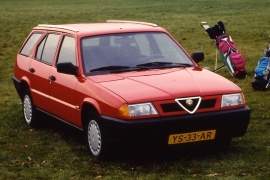ALFA ROMEO 33 Sport Wagon Models/Series Timeline, Specifications & Photos
First production year: 1988
Engines: Gasoline
Body style: Wagon (station wagon, estate, combi, touring)
In 1988, Alfa Romeo renamed the 4x4 longroof version for the 33 model, and the automaker didn't want to call it a station wagon, so it used the Sport Wagon instead.
After four years on the market, the Giardinetta version of the 33 model had to go through some changes, and the Italian carmaker needed to replace the nameplate as well. Since they didn't live in rural areas, customers from cities were not that attracted by a vehicle that sported a small garden (giardinetta) nameplate. Furthermore, customers from villages were not particularly drawn by this stylish vehicle. Last but not least, the automaker dropped the 33 from the moniker, so the car was sold bearing just the Sport Wagon nameplate.
Designed by Pininfarina, the Sport Wagon was 13 cm (5.1") longer than its hatchback sibling. Alfa Romeo placed rhomboidal side windows between the C- and the raked-forward D-pillars, which helped it keep the same rear doors as on the rest of the 33 range. However, since the vehicle was no longer intended for rough roads, it didn't sport the black, lower-side protection trims.
Inside, the car was similar to the regular Alfa 33. It sported a three-spoke steering wheel and a narrow, flat-designed dashboard. There was room for two adults at the front, separated by a small transmission tunnel between them. A feature remained from the all-wheel drive versions. But, on the other hand, that tunnel prevented the car from accommodating three passengers in the back comfortably.
The revised engine range comprised new flat-four powerplants with either front- or all-wheel-drive systems. All versions came fitted with five-speed manual gearboxes.
